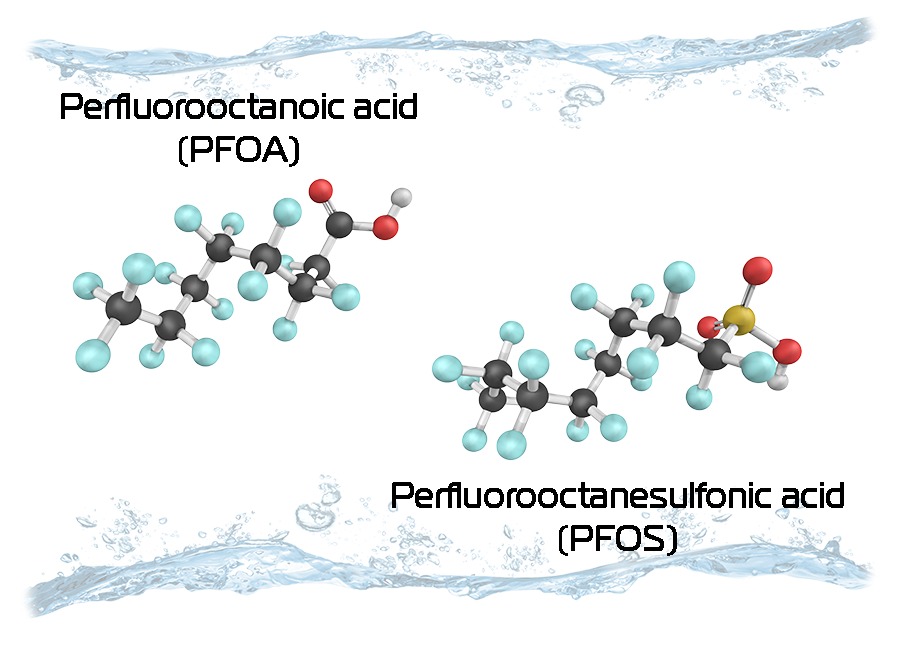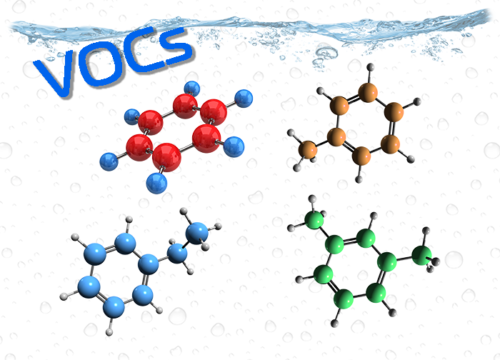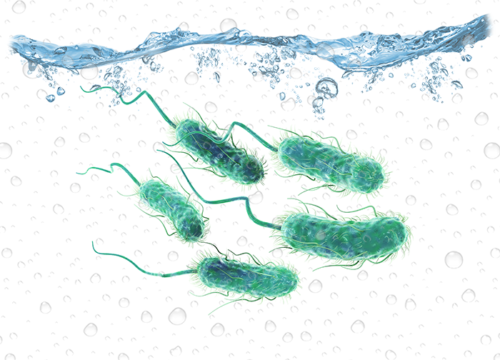What Are Polyfluoroalkyl Substances?
Polyfluoroalkyl Substances (PFAS) are a group of manufactured chemicals that have been used in industry and consumer products since the 1940s because of their useful properties. There are thousands of different PFAS, some of which have been more widely used and studied than others.
Perfluorooctanoic acid (PFOA) and Perfluorooctanesulfonic acid (PFOS), for example, are two of the most widely used and studied chemicals in the PFAS group. PFOA and PFOS have been replaced in the United States with other PFAS in recent years.
One common characteristic of concern of PFAS is that many break down very slowly and can build up in people, animals, and the environment over time.
PFAS can be present in our water, soil, air, and food as well as in materials found in our homes or workplaces, including:
- Drinking water – in public drinking water systems and private drinking water wells.
- Soil and water at or near waste sites – at landfills, disposal sites, and hazardous waste sites such as those that fall under the federal Superfund and Resource Conservation and Recovery Act programs.
If You Get Your Water from a Public Drinking Water System
There are several steps you can take to find out if PFAS is in your drinking water and if it is, reduce your exposure.
- Find out if PFAS are in your drinking water: If you get your water from a public drinking water system, reach out to your local water utility to learn about how they may be addressing PFAS as well as ask them to test the water for PFAS or to share information with you if they have already tested the water. NOTE: Some public drinking water systems may not have this information. If you choose to test your water yourself, it is important to use a state-certified laboratory using EPA-developed testing methods (see section below on private wells).
- Compare your results to your state’s standards for safe levels of PFAS in drinking water. If your state does not have standards, compare your levels to EPA’s Health Advisory levels for certain PFAS.
- If you remain concerned about the level of PFAS in your drinking water, you can:
- Contact your state environmental protection agency or health department and your local water utility to find out what actions they recommend.
- Consider installing in-home water treatment (e.g., filters) that are certified to lower the levels of PFAS in your water.
If You Get Your Water from a Domestic Well
EPA does not regulate or provide recommended standards for private wells. However, EPA does provide valuable information on well testing and guidance on technologies that may be used to treat or remove contaminants.
For example:
- Conduct regular well testing – for information on the overall quality of the water and whether it contains PFAS.
- Compare your results to your state standards for safe levels PFAS in drinking water. If you state does not have standards, compare your levels to EPA’s Health Advisory levels for PFOA and PFOS.
- If you remain concerned about the level of PFAS in your drinking water:
- Contact your state environmental protection agency or health department and your local water utility to find out what actions they recommend.
- If possible, consider using an alternate water source for drinking, preparing food, cooking, brushing teeth, preparing baby formula, and any other activity when your family might swallow water.
- Consider installing an in-home water treatment (e.g., filters) that are certified to lower the levels of PFAS in your water.
Health Effects
Current scientific research suggests that exposure to high levels of certain PFAS may lead to adverse health outcomes. However, research is still ongoing to determine how different levels of exposure to different PFAS can lead to a variety of health effects. Research is also underway to better understand the health effects associated with low levels of exposure to PFAS over long periods of time, especially in children.
Current peer-reviewed scientific studies have shown that exposure to certain levels of PFAS may lead to:
- Reproductive effects such as decreased fertility or increased high blood pressure in pregnant women.
- Developmental effects or delays in children, including low birth weight, accelerated puberty, bone variations, or behavioral changes.
- Increased risk of some cancers, including prostate, kidney, and testicular cancers.
- Reduced ability of the body’s immune system to fight infections, including reduced vaccine response.
- Interference with the body’s natural hormones.
- Increased cholesterol levels and/or risk of obesity.
Published Health Advisories for Per- and Polyfluoroalkyl Substances (PFAS):
WE OFFER TWO PFAS TEST METHODS
- Method 537.1 includes 18 PFAS compounds.
- Method 533 includes 25 PFAS compounds.
| EPA Method 533 & 537.1 COMPOUNDS | ||
| Present in EPA 533 & 537.1 | Only in EPA 533 | Only in EPA 537.1 |
| HFPO-DA | 4:2 FTS | NEtFOSAA |
| PFBS | 6:2 FTS | NMeFOSAA |
| PFDA | 8:2 FTS | PFTA |
| PFDoA | NFDHA | PFTrDA |
| PFHpA | PFBA | |
| PFHxS | PFEESA | |
| PFHxA | PFHpS | |
| PFNA | PFMPA | |
| PFOS | PFMBA | |
| PFOA | PFPeA | |
| PFUnA | PFPeS | |
| 11 CI-PF30UdS | ||
| 9 CI-PF30NS | ||
| ADONA | ||
| Source: https://sampleprep.biotage.com/expandyourhorizon/the-difference-between-epa-method-533-vs-537.1 | ||
EPA METHOD 537.1 (18 compounds)
DETERMINATION OF SELECTED PER- AND POLYFLUORINATED ALKYL SUBSTANCES IN DRINKING WATER BY SOLID PHASE EXTRACTION AND LIQUID CHROMATOGRAPHY/TANDEM MASS SPECTROMETRY (LC/MS/MS)
An EPA validated method, Method 537.1 was developed to replace Method 537 and is commonly used for drinking water compliance. In addition to analyzing for the 14 compounds covered by Method 537, Method 537.1 also analyzes for four replacement PFAS*, including 11Cl-PF3OUdS, 9Cl-PF3ONS, ADONA, and HFPO-DA (also known as Gen X).
*Replacement PFAS are short-chain, potentially less toxic PFAS compounds used to replace PFAS with known toxicity, such as PFOA and PFOS.
| Analyte | CAS # |
| * Hexafluoropropylene oxide dimer acid (HFPO-DA) |
13252-13-6b |
| N-ethyl perfluorooctanesulfonamidoacetic acid (NEtFOSAA) |
2991-50-6 |
| N-methyl perfluorooctanesulfonamidoacetic acid (NMeFOSAA) |
2355-31-9 |
| Perfluorobutanesulfonic acid (PFBS) | 375-73-5 |
| Perfluorodecanoic acid (PFDA) | 335-76-2 |
| Perfluorododecanoic acid (PFDoA) | 307-55-1 |
| Perfluoroheptanoic acid (PFHpA) | 375-85-9 |
| Perfluorohexanesulfonic acid (PFHxS) | 355-46-4 |
| Perfluorohexanoic acid (PFHxA) | 307-24-4 |
| Perfluorononanoic acid (PFNA) |
375-95-1 |
| Perfluorooctanesulfonic acid (PFOS) | 1763-23-1 |
| Perfluorooctanoic acid (PFOA) | 335-67-1 |
| Perfluorotetradecanoic acid (PFTA) |
0376-06-07 |
| Perfluorotridecanoic acid (PFTrDA) |
72629-94-8 |
| Perfluoroundecanoic acid (PFUnA) | 2058-94-8 |
| * 11-chloroeicosafluoro-3-oxaundecane-1-sulfonic acid (11Cl-PF3OUdS) |
763051-92-9c |
| * 9-chlorohexadecafluoro-3-oxanonane-1-sulfonic acid (9Cl-PF3ONS) |
756426-58-1d |
| * 4,8-dioxa-3H-perfluorononanoic acid (ADONA) | 919005-14-4e |
EPA METHOD 533 (25 compounds)
DETERMINATION OF PER- AND POLYFLUOROALKYL SUBSTANCES IN DRINKING WATER BY ISOTOPE DILUTION ANION EXCHANGE SOLID PHASE EXTRACTION AND LIQUID CHROMATOGRAPHY/TANDEM MASS SPECTROMETRY (LC/MS/MS)
Method 533 expanded the number of PFAS compounds that can be analyzed for in drinking water samples. Method 533 also utilizes isotope dilution, providing additional quality control for accuracy of reporting, especially at ppt levels. Method 533 does not replace Method 537.1, but together, the tests can be used to analyze for 29 PFAS compounds. Method 533 is also commonly used for drinking water compliance.
| Analyte | CAS # |
| Perfluorobutanoic acid (PFBA) | 375-22-4 |
| Perfluoro-3-methoxypropanoic acid (PFMPA) | 377-73-1 |
| Perfluoropentanoic acid (PFPeA) | 2706-90-3 |
| Perfluorobutanesulfonic acid (PFBS) | 375-73-5 |
| Perfluoro-4-methoxybutanoic acid (PFMBA) | 863090-89-5 |
| Perfluoro(2-ethoxyethane)sulfonic acid (PFEESA) | 113507-82-7 |
| Nonafluoro-3,6-dioxaheptanoic acid (NFDHA) | 151772-58-6 |
| 3,3,4,4,5,5,6,6,6-nonafluorohexane-1-sulfonic acid (4:2 FTS) | 757124-72-4 |
| Perfluorohexanoic acid (PFHxA) | 307-24-4 |
| Perfluoropentanesulfonic acid (PFPeS) | 2706-91-4 |
| 2-(Heptafluoropropoxy)tetrafluoropropionic acid (HFPO-DA) | 13252-13-6 |
| Perfluoroheptanoic acid (PFHpA) | 375-85-9 |
| Perfluorohexanesulfonic acid (PFHxS) | 355-46-4 |
| 4,8-Dioxa-3H-perfluorononanoic acid (ADONA) | 919005-14-4 |
| 3,3,4,4,5,5,6,6,7,7,8,8,8-tridecafluorooctane-1-sulfonic acid (6:2 FTS) | 27619-97-2 |
| Perfluorooctanoic acid (PFOA) | 335-67-1 |
| Perfluoroheptanesulfonic Acid (PFHpS) | 375-92-8 |
| Perfluorononanoic acid (PFNA) | 375-95-1 |
| Perfluorooctanesulfonic acid (PFOS) | 1763-23-1 |
| Perfluoro(2-((6-chlorohexyl)oxy)ethanesulfonic acid) (9Cl-PF3ONS) | 756426-58-1 |
| 3,3,4,4,5,5,6,6,7,7,8,8,9,9,10,10,10-heptadecafluorodecanesulphonic acid (8:2 FTS) | 39108-34-4 |
| Perfluorodecanoic acid (PFDA) | 335-76-2 |
| Perfluoroundecanoic acid (PFUnA) | 2058-94-8 |
| 11-chloroeicosafluoro-3-oxaundecane-1-sulfonicacid (11Cl-PF3OUdS) | 763051-92-9 |
| Perfluorododecanoic acid (PFDoA) | 307-55-1 |






